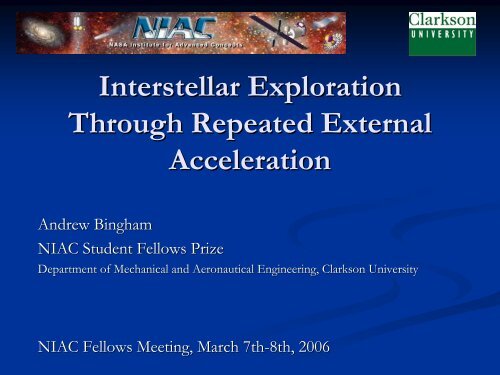Andrew Bingham - NASA's Institute for Advanced Concepts
Andrew Bingham - NASA's Institute for Advanced Concepts
Andrew Bingham - NASA's Institute for Advanced Concepts
- No tags were found...
You also want an ePaper? Increase the reach of your titles
YUMPU automatically turns print PDFs into web optimized ePapers that Google loves.
Interstellar ExplorationThrough Repeated ExternalAcceleration<strong>Andrew</strong> <strong>Bingham</strong>NIAC Student Fellows PrizeDepartment of Mechanical and Aeronautical Engineering, Clarkson UniversityNIAC Fellows Meeting, March 7th-8th, 2006
Agenda• Introduction/Background• Repeated External Acceleration Concept• Current Study• Future Work• Acknowledgements/References
The Heliosphere
Current Missions•Voyager 1 & 2•Launched in 1977•Extended Interstellar mission•Passing Termination Shock•Communications until 2020 andapproximately 120 AU•Pluto New Horizons•Launched December 2005•Extended mission to visitKuiper Belt Objects•Communications until 2020and approximately 50 AU
Future Scientific Objectives• Investigate physical properties andcomposition of local interstellar medium<strong>for</strong> comparison to solar system andgalactic abundance.• Measure cosmic ray nuclei and electronswithout the interference of theheliosphere.• Gather data on astrophysical processessuch as acceleration by supernovashockwaves, interstellar radio and x-ray xemissions, nucleosynthesis, , and thedynamics of interstellar medium.• Per<strong>for</strong>m direct measurements of thesize and structure of the heliosphere.
Agenda• Introduction/Background• Repeated External Acceleration Concept• Current Study• Future Work• Acknowledgements/References
Repeated External Acceleration• Acceleration stationsexternal to thespacecraft provideprimary propulsion.• Stations are positionedthroughout the solarsystem.• Form a ‘solar systemsized slingshot’
Repeated External Acceleration• Architecture is reusable and expandable.• Stations can carry out other functions in-situ.• Major issues include trajectory planning, stationand probe hardware configurations
Agenda• Introduction/Background• Repeated External Acceleration Concept• Current Study• Trajectory Analysis• Station Configuration• Probe Configuration• Future Work• Acknowledgements/References
Trajectory Analysis• Critical Trajectory Features• Reach 200AU in 10-15 15 years• Exit heliosphere in direction ofbow shock• Problem Space Simplification• No station at Mars due to smallgravity assist available• Stations at multiple outerplanets avoided due to longorbital periods• Two main cases• Single station in Earth orbit• Dual stations in Earth andJupiter orbits
Basic CalculationsBased on travel to 200AU in 15 years:• Single station at Earth requires Vinf = 63.2 km/s400Delta Vinf at Jupiter vs Delta Vinf at Earth, 200AU in 15 years350300Delta Vinf Jupiter25020015010050010 20 30 40 50 60 70Delta Vinf Earth• Dual 40 km/s stations at Earth & Jupiter
Requested Software• SNAP – NASA Glenn• Spacecraft N-Body NAnalysis Program• Propagates using 8 th order Runge-KuttaFehlberg routine• MIDAS – Jet Propulsion Laboratory• Patched conic trajectory optimization program• Capable of automatically varying, adding, deleting missionphases• Satellite Toolkit• Industry standard trajectory planning tool
SNAP• SNAP runs in Linux andother UNIX/BSDenvironments.• Input and output are inthe <strong>for</strong>m of <strong>for</strong>mattedtext.• Fortran source code isavailable <strong>for</strong> customapplications.• Does not per<strong>for</strong>moptimization.
SNAP• Input files <strong>for</strong> the twocases of stationconfiguration are beingcreated.• Case 1 – Single station inLEO• Case 2 – Dual stations inLEO and Jupiter orbits• Station accelerationscurrently modeled asimpulsive.
Further Optimization• By wrapping an optimization code aroundSNAP, more efficient trajectories can be found.• Currently, a simple optimizer is being writtenusing GNU/Octave.• Capable of varying parameters within therepresentative input files and comparing resultingoutput <strong>for</strong> mission success based on criticaltrajectory limitations.
Station ConfigurationLinear AcceleratorTether• MagBeam Station Selected• Scaleable system.• Does not require large space structure.• Longer interaction times reduce spacecraft loading.• Hardware currently being demonstrated.MagBeam
Probe Configuration• Pluto New Horizons spacecraftshares many characteristics withinterstellar probes.• Long-duration deep space mission.• Mass minimized (~500kg) toachieve high velocity.• Some instruments designed tomeasure plasma and solar windinteractions.• Further reducing the payloadmass through miniaturizationcould allow the use of a PNH-derived spacecraft <strong>for</strong> anexternally accelerated mission tobow shock.
Probe PayloadInstruments:•Magnetometer•Plasma and Radio Wave Sensor•Solar Wind/Interstellar Plasma/Electron Spectrometer•Pickup and Interstellar Ion Isotope Spectrometer•Interstellar Neutral Atom Spectrometer•Suprathermal Ion/Electron Sensor•Cosmic Ray H, He, Electron, Positron, Gamma-Ray Burst Instrument•Anomalous & Galactic Cosmic Ray Isotope Spectrometer•Dust Composition Instrument•Infrared Instrument•Energetic Neutral Atom (ENA) Imager•UV PhotometerResource Requirements:•Power – 20W•Communications – 25bps•Mass – 25kg
Technology ReadinessArchitecture ComponentTRLMagBeam System TRL 4Space Nuclear Power Supply TRL 6Autonomous Rendezvous TRL 9<strong>Advanced</strong> Deep Space Vehicle TRL 9Miniaturized Instrument Suite TRL 3
Agenda• Introduction/Background• Repeated External Acceleration Concept• Current Study• Future Work/Outreach• Acknowledgements/References
Continuing Work & Outreach• Complete trajectory analysis• Potential Case 3 – LEO + Mars Stations• Publish Web Site• Present at AIAA Region I-NE IStudentConference, March 30 th -April 1 st• Present at Clarkson University Symposium <strong>for</strong>Undergraduate Research, April 7 th• Final Report
Agenda• Introduction/Background• Repeated External Acceleration Concept• Current Study• Future Work/Outreach• Acknowledgements/References
Acknowledgements• NIAC, <strong>for</strong> providing the resources to continueworking on this project.• Dr. Kenneth Visser, , <strong>for</strong> advising me throughoutthe process.• NASA Glenn <strong>for</strong> providing SNAP.• AGI <strong>for</strong> providing STK.• Family, friends, and everyone else whosupported me throughout the last year.
ReferencesAnalytical Graphics, Inc, Satellite Toolkit, v.6.2.Hoyt, et. al, A Modular Momentum-Exchange/Electrodynamic-Reboost Tether SystemArchitecture, AIAA-2003-2514.Interstellar Boundary Explorer Science Strategy.http://www.ibex.swri.edu/mission/strategy.shtmlMartini, Michael. Spacecraft N-Body Analysis Program 2.3 Users Guide. AnalexCorperation, NASA Glenn Research Center, 2005.Mewaldt, R. A., and Liewar, P. C., An Interstellar Probe Mission to the Boundaries of theHeliosphere and Nearby Interstellar Space, NASA Jet Propulsion Laboratory,1999.Pluto New Horizons Science Payload,http://pluto.jhuapl.edu/spacecraft/sciencePay.htmlRiehl, Phil. Tools Used By Analysis & Integration Group – MIDAS.http://trajectory.grc.nasa.gov/tools/midas.shtmlVallado, David A, Fundamentals of Astrodynamics and Applications,Microcosm, 2001.Winglee, et. al, Magnetized Beam Propulsion, NIAC Fellows Meeting 2005.
Questions?
















